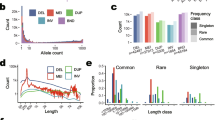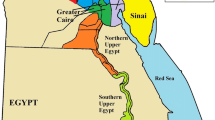Abstract
Previous studies on human DNA have shown that the 3′ poly(A) tracts of Alu elements may display considerable genetic polymorphism. To explore whether this marker type is generally applicable in mammalian genomes, I analyzed porcine SINEs. A database screening revealed 17 porcine sequences with significant homology to a previously identified pig SINE. The occurrence in the database suggested a SINE frequency of one copy every 12 kb of pig DNA. All SINEs contained a 3′ poly(A) tract with an average of 12 uninterrupted adenines. The repetitive regions were analyzed for polymorphism by locus-specific PCR amplification. Allelic length variation (two to five alleles among 10 pigs) was found at 8 out of 10 loci investigated, in most cases probably because of varying number of iterated adenine residues. There was a positive relationship between repeat length and the degree of polymorphism. Stable Mendelian inheritance was documented in 200 meioses each at four loci. The high genomic frequency of SINEs implies that a potentially informative marker may be found near any gene or in any cosmid clone. These SINE 3′ poly(A) polymorphisms, termed SINEVA [SINE variable poly(A)s], thus provide an abundant and useful class of genetic marker in mammalian genomes.
Similar content being viewed by others
References
Akkaya, M.S., Bhagwat, A.A., Cregan, P.B. (1992). Length polymorphisms of simple sequence repeat DNA in soybean. Genetics 132, 1131–1139.
Batzer, M.A., Kilroy, G.E., Richard, P.E., Shaikh, T.H., Desselle, T.D., Hoppens, C.L., Deininger, P.L. (1990). Structure and variability of recently inserted Alu family members. Nucleic Acids Res. 18, 6793–6798.
Beckmann, J.S., Weber, J.L. (1992). Survey of human and rat microsatellites. Genomics 12, 627–631.
Davies, W., Harbitz, I., Fries, R., Stranzinger, G., Hauge, J.G. (1988). Porcine malignant hyperthermia carrier detection and chromosomal assignment using a linked probe. Anim. Genet. 19, 203–212.
Economou, E.P., Bergen, A.W., Warren, A.C., Antonarakis, S.E. (1990). The polydeoxyadenylate tract of Alu repetitive elements is polymorphic in the human genome. Proc. Natl. Acad. Sci. USA 87, 2951–2954.
Edwards, A., Civitello, A., Hammond, H.A., Caskey, C.T. (1991). DNA typing and genetic mapping with trimeric and tetrameric tandem repeats. Am. J. Hum. Genet. 49, 746–756.
Ellegren, H. (1992). Polymerase chain reaction (PCR) analysis of microsatellites—a new approach to studies of genetic relationships in birds. Auk 109, 886–895.
Ellegren, H., Johansson, M., Chowdhary, B.P., Marklund, S., Ruyter, D., Marklund, D., Marklund, L., Bräuner-Nielsen, P., Edfors-Lilja, I., Gustavsson, I., Juneja, R.K., Andersson, L. (1993). Assignment of 20 microsatellite markers to the porcine linkage map. Genomics 16, 431–439.
Epstein, N., Nahor, O., Silver, J. (1990) The 3′ ends of alu repeats are highly polymorphic. Nucleic Acids Res. 18, 4634.
Frengen, E., Thomsen, P., Kristensen, T., Kran, S., Miller, R., Davies, W. (1991). Porcine SINEs: characterization and use in species-specific amplification. Genomics 10, 949–956.
Goff, D.J., Galvin, K., Katz, H., Westerfield, M., Lander, E.S., Tabin, C.J. (1992). Identification of polymorphic simple sequence repeats in the genome of the Zebrafish. Genomics 14, 200–202.
Jagadeeswaran, P., Forget, B.G., Weissman, S.M. (1981). Short interspersed repetitive DNA elements in eucaryotes: transposable DNA elements generated by reverse transcription of RNA pol III transcript? Cell 26, 141–142.
Johansson, M., Ellegren, H., Marklund, L., Gustavsson, U., Ringmar-Cederberg, E., Andersson, K., Edfors-Lilja, I., Andersson, L. (1992). The gene for dominant white color in the pig is closely linked to ALB and PDGFRA on chromosome 8. Genomics 14, 965–969.
Johansson, M., Chowdhary, B., Gu, F., Ellegren, H., Gustavsson, I., Andersson, L. (1993). Genetic analysis of the gene for porcine submaxillary gland mucin (MUC): physical assignment of the MUC and interferon γ (IFNG) genes to chromosome 5. J. Hered., in press.
Kaukinen, J., Varvio, S-L. (1992). Artiodactyl retrosposons: association with microsatellites and use in SINEmorph detection by PCR. Nucleic Acids Res. 20, 2955–2958.
Lagercrantz, U., Ellegren, H., Andersson, L. (1993). The abundance of various polymorphic microsatellite motifs differs between plants and vertebrates. Nucleic Acids Res. 21, 1111–1115.
Lathrop, G.M., Lalouel, J.M. (1988). Efficient computations in multilocus linkage analysis. Am. J. Hum. Genet. 42, 498–505.
Litt, M., Luty, J.A. (1989). A hypervariable microsatellite revealed by in vitro amplification of a dinucleotide repeat within the cardiac muscle actin gene. Am. J. Hum. Genet. 44, 397–401.
Love, J.M., Knight, A.M., McAleer, M.A., Todd, J.A. (1990). Towards construction of a high resolution map of the mouse genome using PCR-analysed microsatellites. Nucleic Acids Res. 18, 4123–4130.
Luty, J.A., Guo, Z., Willard, H.F., Ledbetter, D.H., Ledbetter, S., Litt, M. (1990). Five polymorphic microsatellite VNTRs on the human X chromosome. Am. J. Hum. Genet. 46, 776–783.
Matera, A.G., Hellmann, U., Hintz, M.F., Schmid, C.W. (1990). Recently transposed Alu repeats result from multiple source genes. Nucleic Acids Res. 18, 6019–6023.
Nelson, D.L., Caskey, C.T. (1989) Alu PCR: the use of repeat sequence primers for amplification of human DNA from complex sources. In PCR Technology: Principles and Applications for DNA Amplification, H.A. Erlich, ed. (New York: Stockton Press), pp. 113–118.
Rogers, J.H. (1985). The origin and evolution of retrosposons. Int. Rev. Cytol. 93, 187–279.
Schlötterer, C., Tautz, D. (1992). Slippage synthesis of simple sequence DNA. Nucleic Acids Res. 20, 211–215.
Schmid, C.W., Jelinek, W.R. (1982). The Alu family of dispersed repetitive sequences. Science 216, 1065–1070.
Serikawa, T., Kuramoto, T., Hilbert, P., Mori, M., Yamada, J., Dubay, C.J., Lindpainter, K., Ganten, D., Guénet, J-L., Lathrop, G.M., Beckmann, J.S. (1992). Rat gene mapping using PCR-analysed microsatellites. Genetics 131, 701–721.
Shriver, M.D., Siest, G., Boerwinkle, E. (1992). Length and sequence variation in the apolipoprotein B intron 20 Alu repeat. Genomics 14, 449–454.
Singer, D.S., Parent, L.J., Ehrlich, R. (1987). Identification and DNA sequence of an interspersed repetitive element in the genome of the miniature swine. Nucleic Acids Res. 15, 2780.
Takahashi, H., Awata, T., Yasue, H. (1992). Characterization of swine short interspersed repetitive sequences. Anim. Genet. 23, 443–448.
Tautz, D. (1989). Hypervariability of simple sequences as a general source for polymorphic DNA markers. Nucleic Acids Res. 12, 4127–4138.
Ullu, E., Tschudi, C. (1984). Alu sequences are processed 7SL RNA genes. Nature 312, 171–172.
Van Arsdell, S.W., Denison, R.A., Bernstein, L.B., Weiner, A.M., Manser, T., Gesteland, R.F. (1981). Direct repeats flank three small nuclear RNA pseudogenes in the human genome. Cell 26, 11–17.
Watanabe, Y., Tsukada, T., Notake, M., Nakanishi, S., Numa, S. (1982). Structural analysis of repetitive DNA sequences in the bovine corticotropin-β-lipotropin precursor gene region. Nucleic Acids Res. 10, 1459–1469.
Weber, J.L. (1990). Informativeness of human (dC-dA)n · (dG-dT)n polymorphisms. Genomics 7, 524–530.
Weber, J.L., May, P.E. (1989). Abundant class of human DNA polymorphisms which can be typed using the polymerase chain reaction. Am. J. Hum. Genet. 44, 388–396.
Weiner, A.M., Deininger, P.L., Efstratiadis, A. (1986). Nonviral retrosposons: genes, pseudogenes, and transposable elements generated by the reverse flow of genetic information. Annu. Rev. Biochem. 55, 631–661.
Weissenbach, J., Gyapay, G., Dib, C., Vignal, A., Morissette, J., Millasseau, P., Vaysseix, G., Lathrop, M. (1992). A second-generation linkage map of the human genome. Nature 359, 794–801.
Zuliani, G., Hobbs, H.H. (1990). A high frequency of length polymorphisms in repeated sequences adjacent to Alu sequences. Am. J. Hum. Genet. 46, 963–969.
Author information
Authors and Affiliations
Rights and permissions
About this article
Cite this article
Ellegren, H. Variable SINE 3′ poly(A) sequences: an abundant class of genetic markers in the pig genome. Mammalian Genome 4, 429–434 (1993). https://doi.org/10.1007/BF00296816
Received:
Accepted:
Issue Date:
DOI: https://doi.org/10.1007/BF00296816




